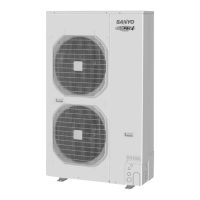2
2-11
Indoor control unit switch
OPERATION
TIMER STANDBY
Indicator lamps
2-13. Test Run
Using the control unit
(1) Change the indoor control unit switch from
“ON” “TEST”.
(The outdoor unit will not operate for 3 minutes after
the power is turned ON and after operation is stop-
ped.)
(2) All the indicator lamps blink while the test run is in
progress.
(3) Temperature control is not possible during the test
run.
(4) If correct operation is not possible, the trouble will
be indicated by the indicator lamps. Refer to “Table
of Self Diagnostic Functions and Corrections” and
correct the problem.
(5) After the test is completed, change the control unit
switch from “TEST” “ON”. Confirm that the
indicator lamps have stopped blinking. (A function is
included which cancels the test run after a 60-minute
timer has elapsed, in order to prevent continuous
test run operation.)
ON
OFF
TEST
NOTE
This mode places a large load on the devices. Use it
only for performing test runs.
A test run is not possible if the power is turned ON
with the switch in the TEST position.
After the power has been turned ON, change the
switch once to ON or OFF, then switch it back to the
TEST position.
2-14. Precautions
Request that the customer be present when the test
run is performed. At this time, explain the operation
manual and have the customer perform the actual
steps.
Be sure to pass the manuals and warranty certificate
to the customer.
Check that the 220 – 240 V AC wiring is not connec-
ted to the inter-unit control wiring connector terminal.
* If 220 – 240 V AC is accidentally applied, the indoor
or outdoor unit control PCB fuse (0.5 A for both
indoor and outdoor units) will blow in order to protect
the PCB. Correct the wiring connections, then
disconnect the 2P connectors (indoor: blue) (outdoor:
blue, serial 1) that are connected to the PCB, and
replace them with 2P connectors (indoor: brown)
(outdoor: brown, serial 2).
If operation is still not possible after changing the
brown connectors, try cutting the varistor (black)
(both indoor and outdoor).
(Be sure to turn the power OFF before performing
this work.) (Fig. 2-10)
8 – 10 HP
LED1
FUSE (0.5A, F500)
OC (CN500, BLU)
MOV2
(CN301, BLK)
MOV1
(CN300, WHT)
EMG (CN502, BRN)
SILENT (CN037, WHT)
PUMP DOWN (CN048)
TEMINAL (CN205, BLK)
R.C.ADD. Rotary switch
C2 (CN020, WHT)
C1 (CN021, WHT)
TEST (CN033, RED)
TD (CN024, BLK)
TO (CN023, BLK)
TS (CN022, RED)
63PH (CN027, WHT)
EXCT
(CN030, RED)
RC P
(CN039, RED)
IC002
CTL2
(CN202, GRN)
CTL1
(CN203, GRN)
FUSE
(6.3A, F101)
N.P.CHECK
(CN046, RED)
LED2
MODE (CN038)
D115
IC001
R.C.ADD. DIP switch
A.ADD (CN047)
C-CHK (CN035)
EEPROM
LED (D041)
Fig. 2-10
Indoor unit control PCB
Varistor (black)
VA002
Fuse (0.5A)
CHK (2P plug)
SW103
2P connector (brown)
2P connector (blue)
ON
OFF
TEST
2 HP
TEST
ON
OFF
3 HP
Fuse (0.5A)
2P connector (blue)
2P connector (brown)
SW103
Varistor (black)
VA002
CHK (2P plug)
Outdoor unit control PCB
SM830161Book.indb11SM830161Book.indb11 2008/06/039:09:032008/06/039:09:03

